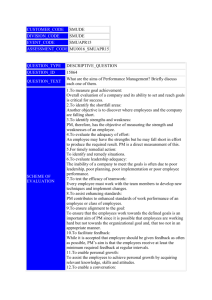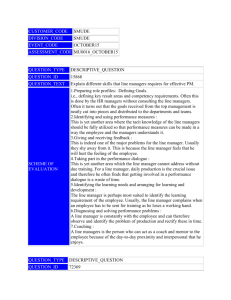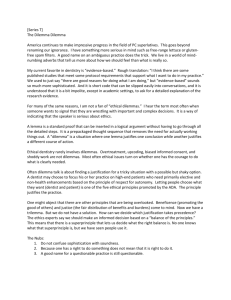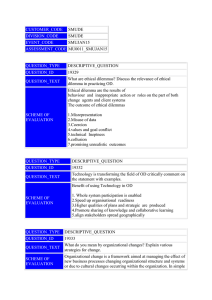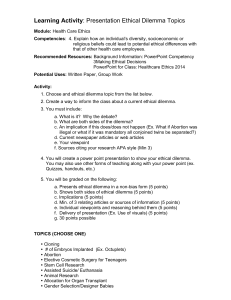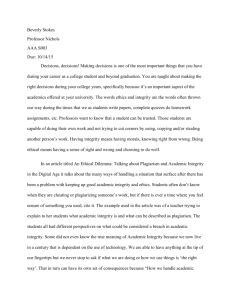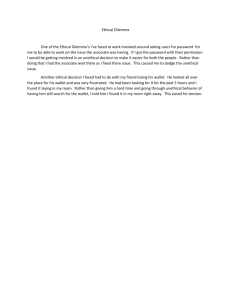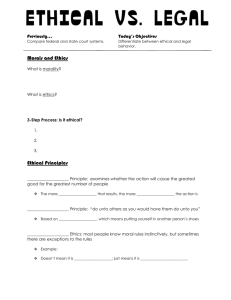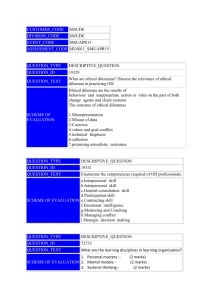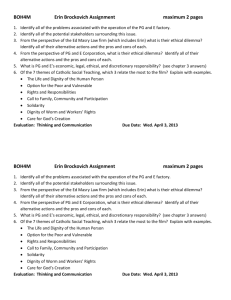CUSTOMER_CODE SMUDE DIVISION_CODE SMUDE
advertisement
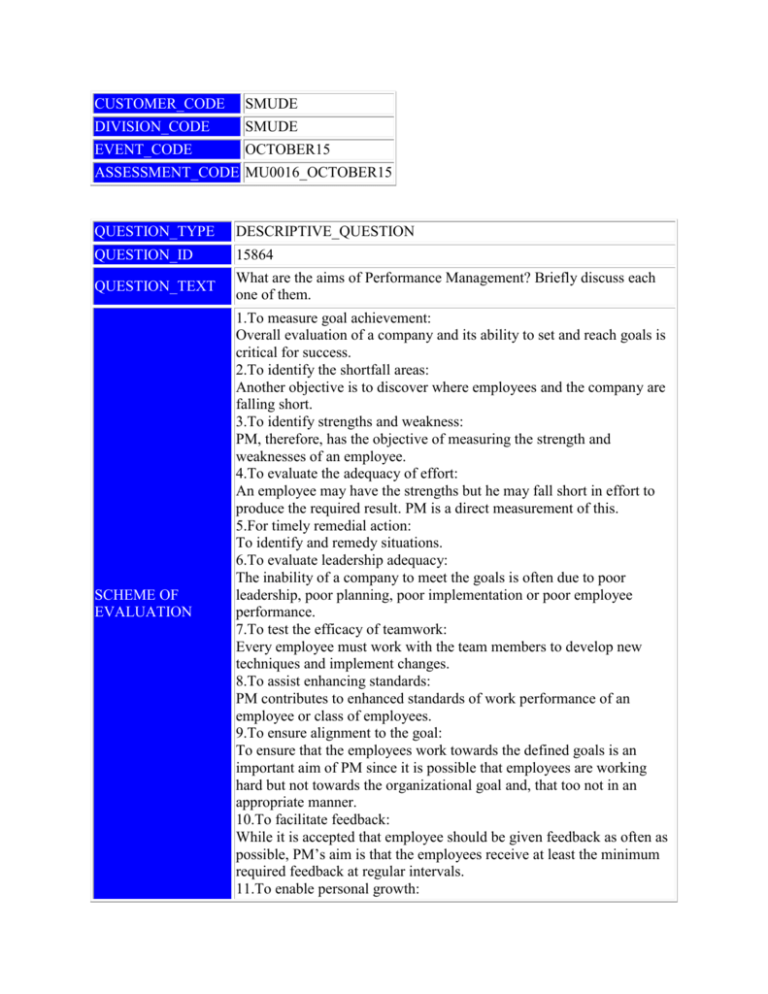
CUSTOMER_CODE SMUDE DIVISION_CODE SMUDE EVENT_CODE OCTOBER15 ASSESSMENT_CODE MU0016_OCTOBER15 QUESTION_TYPE DESCRIPTIVE_QUESTION QUESTION_ID 15864 QUESTION_TEXT What are the aims of Performance Management? Briefly discuss each one of them. SCHEME OF EVALUATION 1.To measure goal achievement: Overall evaluation of a company and its ability to set and reach goals is critical for success. 2.To identify the shortfall areas: Another objective is to discover where employees and the company are falling short. 3.To identify strengths and weakness: PM, therefore, has the objective of measuring the strength and weaknesses of an employee. 4.To evaluate the adequacy of effort: An employee may have the strengths but he may fall short in effort to produce the required result. PM is a direct measurement of this. 5.For timely remedial action: To identify and remedy situations. 6.To evaluate leadership adequacy: The inability of a company to meet the goals is often due to poor leadership, poor planning, poor implementation or poor employee performance. 7.To test the efficacy of teamwork: Every employee must work with the team members to develop new techniques and implement changes. 8.To assist enhancing standards: PM contributes to enhanced standards of work performance of an employee or class of employees. 9.To ensure alignment to the goal: To ensure that the employees work towards the defined goals is an important aim of PM since it is possible that employees are working hard but not towards the organizational goal and, that too not in an appropriate manner. 10.To facilitate feedback: While it is accepted that employee should be given feedback as often as possible, PM’s aim is that the employees receive at least the minimum required feedback at regular intervals. 11.To enable personal growth: To assist the employees to achieve personal growth by acquiring relevant knowledge, skills and attitudes. 12.To enable a conversation: PM is perhaps the ideal method for an intimate one – one conversation with the supervisors. This in turn creates an excellent work atmosphere. QUESTION_TYPE DESCRIPTIVE_QUESTION QUESTION_ID 15868 QUESTION_TEXT Explain different skills that line managers requires for effective PM. SCHEME OF EVALUATION 1.Preparing role profiles: Defining Goals. i.e., defining key result areas and competency requirements. Often this is done by the HR managers without consulting the line managers. Often it turns out that the goals received from the top management is neatly cut into pieces and distributed to the departments and teams. 2.Identifying and using performance measures : This is yet another area where the tacit knowledge of the line managers should be fully utilized so that performance measures can be made in a way the employee and the managers understands it. 3.Giving and receiving feedback : This is indeed one of the major problems for the line manager. Usually they shy away from it. This is because the line manager feels that he will hurt the feeling of the employee. 4.Taking part in the performance dialogue : This is yet another area which the line manager cannot address without due training. For a line manager, daily production is the crucial issue and therefore he often finds that getting involved in a performance dialogue is a waste of time. 5.Identifying the learning needs and arranging for learning and development : The line manager is perhaps most suited to identify the learning requirement of the employee. Usually, the line manager complains when an employee has to be sent for training as he loses a working hand. 6.Diagnosing and solving performance problems : A line manager is constantly with the employee and can therefore observe and identify the problem of production and rectify these in time. 7.Coaching : A line managers is the person who can act as a coach and mentor to the employee because of the day-to-day proximity and interpersonal that he enjoys. QUESTION_TYPE DESCRIPTIVE_QUESTION QUESTION_ID 72363 QUESTION_TEXT Explain any five ways to create employee engagement. SCHEME OF EVALUATION 1. Communicate clear goals and expectations to the employees 2. Share information 3. Encourage open communication 4. Culture and value s 5. Creating trust 6. Role of prompt feedback 7. Incentives 8. Delegation QUESTION_TYPE DESCRIPTIVE_QUESTION QUESTION_ID 72364 QUESTION_TEXT Explain the different aspects of performance expectations defined by performance agreement. SCHEME OF EVALUATION 1. 2. 3. 4. 5. Role requirement Objectives and standards of performance e Knowledge, skill and capabilities Performance measures and indicators Corporate core values or requirements QUESTION_TYPE DESCRIPTIVE_QUESTION QUESTION_ID 72369 a. Explain the absolute standard evaluation system. QUESTION_TEXT b. Discuss any three ethical dilemma situations under performance management system SCHEME OF EVALUATION a. Absolute standard evaluation system :This evaluation system evaluates individuals for several criteria such as initiative, target achievement, etc. And rates them accordingly. Employees are not compared with each other. 4 marks b) 1.Ethical dilemma 1: Use of trait-oriented or subjective evaluation criteria : 2. Ethical dilemma 2: problem in the writing of performance standards and measurement indicators. 3. Ethical dilemma 3: The use of different PA system within the same organisation. 4. Ethical dilemma 4: How are the results of PA to be used? 5. Ethical dilemma 5: who determines the objective standards (6 marks) QUESTION_TYPE DESCRIPTIVE_QUESTION QUESTION_ID 125967 a. Discuss the principles of performance management. b. Explain the steps in end cycle review process. QUESTION_TEXT a. The various principles performance management: Integration of individual and organisational objectives: Specificity: Measurability: Mutual Agreement: Continuity: Customisation: Flow: explanation to be picked from U 3.5 Page 43+6 marks SCHEME OF EVALUATION b. Steps in end cycle review process: Step 1 – Employee prepares self assessment: Step 2 – Manager/Supervisor prepares the achievement: Step 3– Discuss the achievement: Refer to explanation provided under U4 P 64+4 marks
